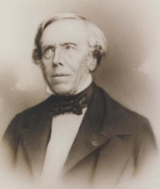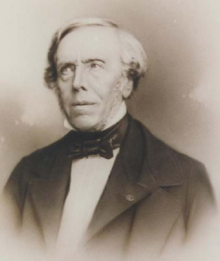
Jean-Baptiste-Charles-Joseph Bélanger
Encyclopedia

France
The French Republic , The French Republic , The French Republic , (commonly known as France , is a unitary semi-presidential republic in Western Europe with several overseas territories and islands located on other continents and in the Indian, Pacific, and Atlantic oceans. Metropolitan France...
applied mathematician
Mathematician
A mathematician is a person whose primary area of study is the field of mathematics. Mathematicians are concerned with quantity, structure, space, and change....
who worked in the areas of hydraulics
Hydraulics
Hydraulics is a topic in applied science and engineering dealing with the mechanical properties of liquids. Fluid mechanics provides the theoretical foundation for hydraulics, which focuses on the engineering uses of fluid properties. In fluid power, hydraulics is used for the generation, control,...
and hydrodynamics. He was a professor at the Ecole Centrale des Arts et Manufactures, Ecole Polytechnique
École Polytechnique
The École Polytechnique is a state-run institution of higher education and research in Palaiseau, Essonne, France, near Paris. Polytechnique is renowned for its four year undergraduate/graduate Master's program...
and École des Ponts et Chaussées in France. In hydraulic engineering, he is often credited improperly for the application of the momentum principle to a hydraulic jump
Hydraulic jump
A hydraulic jump is a phenomenon in the science of hydraulics which is frequently observed in open channel flow such as rivers and spillways. When liquid at high velocity discharges into a zone of lower velocity, a rather abrupt rise occurs in the liquid surface...
in a rectangular open channel in 1828. His true contribution in 1828 was the development of the backwater equation for gradually-varied flows in open channels (Bélanger 1828) and the application of the momentum principle to the hydraulic jump flow in 1838 (Bélanger 1841).
Life of Bélanger
Born in Valenciennes (France) on 4 April 1790, Bélanger was the son of Charles Antoine Aimé Joseph Bélanger, master locksmith, and of Jeanne Françoise Joseph . He studied in Paris at the Ecole PolytechniqueÉcole Polytechnique
The École Polytechnique is a state-run institution of higher education and research in Palaiseau, Essonne, France, near Paris. Polytechnique is renowned for its four year undergraduate/graduate Master's program...
and later at the Ecole des Ponts et Chaussées
École Nationale des Ponts et Chaussées
Founded in 1747, the École nationale des ponts et chaussées , often referred to as les Ponts, is the world's oldest civil engineering school...
.
As Ingénieur du Corps des Ponts et Chaussées, he started his engineering career in 1816 at La Réole. From 1821, he moved to work on the Somme navigation canal and after 1826 on the Ardennes navigation canal. It was during these two missions that he studied specifically the hydraulics of gradually-varied open channel flows. He later became a lecturer at the Ecole Centrale des Arts et Manufactures between 1838 and 1864, at the Ecole des Ponts et Chaussées
École Nationale des Ponts et Chaussées
Founded in 1747, the École nationale des ponts et chaussées , often referred to as les Ponts, is the world's oldest civil engineering school...
from 1841 to 1855, and at the Ecole Polytechnique
École Polytechnique
The École Polytechnique is a state-run institution of higher education and research in Palaiseau, Essonne, France, near Paris. Polytechnique is renowned for its four year undergraduate/graduate Master's program...
from 1851 to 1860 (Chatzis 1995). At the Ecole Centrale, one of his students was Gustave Eiffel
Gustave Eiffel
Alexandre Gustave Eiffel was a French structural engineer from the École Centrale Paris, an architect, an entrepreneur and a specialist of metallic structures...
(1832–1923) who built the Eiffel tower and engraved Bélanger's name around the first floor together with the names of 71 other scientists.
Jean-Baptiste Bélanger retired in 1864 and died on 8 May 1874 at Neuilly-sur-Seine where his body was buried.
Contribution to open channel hydraulics
During his professional career, his 1828 treatise was a major contribution to modern open channel hydraulics (Chanson 2008,2009). The work was focused on the study of gradually varied open channel flows (Bélanger 1828). The originality of Bélanger's (1828) essay was the successful development of the backwater equation for steady, one-dimensional gradually-varied flows in an open channel, together with the introduction of the step method, distance calculated from depth, and the concept of critical flow conditions. In 1828, Jean-Baptiste Bélanger understood the rapidly-varied nature of the jump flow, but he applied incorrectly the Bernoulli principle to the hydraulic jumpHydraulic jump
A hydraulic jump is a phenomenon in the science of hydraulics which is frequently observed in open channel flow such as rivers and spillways. When liquid at high velocity discharges into a zone of lower velocity, a rather abrupt rise occurs in the liquid surface...
.
The correct application of momentum considerations to the hydraulic jump flow was derived 10 years later and first published by Bélanger (1841) as part of a series of lecture notes for the École nationale des ponts et chaussées
École Nationale des Ponts et Chaussées
Founded in 1747, the École nationale des ponts et chaussées , often referred to as les Ponts, is the world's oldest civil engineering school...
. His notes formed a comprehensive treatise in hydraulic engineering (Chanson 2008). They were re-edited several times and used at the Ecole des Ponts et Chaussées and Ecole Centrale des Arts et Manufactures, and available at the Ecole Polytechnique et Ecole des Mines de Paris
Altogether Jean-Baptiste Bélanger's (1828,1841) contributions to modern open channel hydraulics were remarkable and influenced the works by Jacques Antoine Charles Bresse
Jacques Antoine Charles Bresse
Jacques Antoine Charles Bresse was a French civil engineer who specialized in the design and use of hydraulic motors....
, Henry Darcy
Henry Darcy
Henry Philibert Gaspard Darcy was a French engineer who made several important contributions to hydraulics.-Biography:...
, Henry Émile Bazin, Adhémar Jean Claude Barré de Saint-Venant
Adhémar Jean Claude Barré de Saint-Venant
Adhémar Jean Claude Barré de Saint-Venant was a mechanician and mathematician who contributed to early stress analysis and also developed the one-dimensional unsteady open channel flow shallow water equations or Saint-Venant equations that are a fundamental set of equations used in modern...
, and Joseph Valentin Boussinesq, as well as Philipp Forchheimer
Philipp Forchheimer
Philipp Forchheimer was an Austrian engineer, a pioneer in the field of civil engineering and practical hydraulics...
and Boris Bakhmeteff
Boris Bakhmeteff
Boris Alexandrovich Bakhmeteff was an engineer, businessman, professor of Civil Engineering at Columbia University and the only ambassador of the Russian Provisional Government to the United States. He was unrelated to his predecessor as ambassador, George Bakhmeteff. His wife Helen died in 1921...
.
Contribution to applied mechanics
From 1851, as a Full Professor at the Ecole Polytechnique, he developed a new university curriculum in mechanics (cours de Mécanique) in response to a re-structure of the engineering programme at Ecole Polytechnique (Chatzis 1995). Linking kinematics and dynamics, he argued that the mechanics is based upon three principles: inertia, action-reaction and constant ratio force to acceleration at any point. Among the innovations, he considered statics as a limited case of dynamics which was most innovative in France at the time. His basic ideas were first developed in his 1847 lecture notes, and they influenced many leading scholars in France and overseas. For example, Franz ReuleauxFranz Reuleaux
Franz Reuleaux , was a mechanical engineer and a lecturer of the Berlin Royal Technical Academy, later appointed as the President of the Academy. He was often called the father of kinematics...
(1829–1905) respected highly Bélanger's (1847) text ; Ernst Mach
Ernst Mach
Ernst Mach was an Austrian physicist and philosopher, noted for his contributions to physics such as the Mach number and the study of shock waves...
(1838–1916) listed Bélanger's 1847 treatise among a few basic references in Mechanics.

